It can be hard to know exactly when and how to offer certain foods to our littles, but this guide to feeding kids is here to help! Learn when it’s safe for kids to eat popcorn, apples, raisins, milk, honey, gummies, chocolate and so much more!
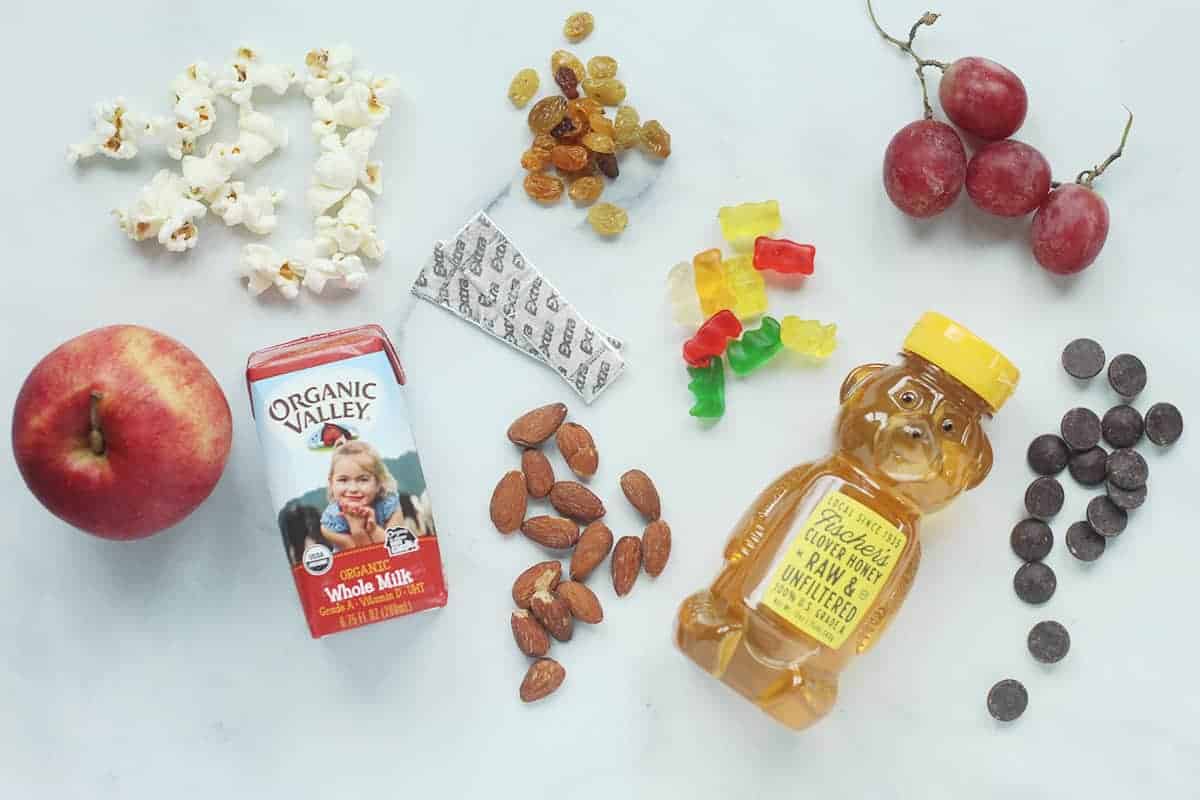
When can kids eat…
We’ll go through the common foods we parents worry about feeding to their kids with the info on when the experts say it’s safe to offer them—with specifics on how to serve them to ensure that they’re safe for the littles to enjoy.
My goal with this post is to run through the most common foods for kids that we have questions on, so if I missed one or didn’t answer your specific question about a food, let me know in the comments at the bottom of the post!
And remember, while I am offering you these recommendations based primarily on safety guidelines, there is a lot of room for personal preference. Always check with your doctor with any specific concerns.
TIP: Use the TOC below to jump right to the foods you’re wondering about.
Table of Contents
- When can kids eat...
- When can kids have apple? (6 mo, with modifications)
- When can kids have lunch meat? (1 yr)
- When can baby eat Cheerios? (8-9 mo)
- When can kids have chocolate?
- When can kids have cocoa powder?
- When can baby have cow's milk? (1 yr)
- When can kids have gum? (4 yr)
- When can kids have gummies and fruit snacks? (2-4 yr)
- When can kids have grapes? (8/9 mo with modifications)
- When can baby have finger foods? (8/9 mo)
- When can kids have fish? (6 mo)
- When can kids have honey? (1 yr)
- When can kids have hot dogs? (1 yr)
- When can kids have juice? (1 yr)
- When can kids have nuts? (6 mo with modifications)
- When can baby have peanut butter? (6 mo)
- When can kids have popcorn? (4 yr)
- When can babies start purees? (6 mo)
- When can kids eat raisins? (1 yr)
- When can kids eat runny eggs? (5 yr)
- When can kids have spicy food? (6 mo)
- When can kids have added sugar?
- When can kids have sushi? (2 years)
- When can kids have tortilla chips? (4 yrs)
- When can baby have water? (6 mo)
- More Food Choking Hazard Info
Your toddler won’t eat? Help is here!
Sign up for our email updates to get tips and ideas sent to your inbox.
When can kids have apple? (6 mo, with modifications)
Kids can have raw apple, if it’s shredded, starting around 12 months. Big chunks of raw apple can be very hard to chew for babies and toddlers and may be a choking hazard. See below for more ways to serve apples.
- 6+ mo: Baked Sliced Apples or Apple Puree.
- 9+ mo: Sauteed Cinnamon Apples
- 12+ mo: Shredded raw apple
- 16/18+ months: Thinly sliced raw apple
- 36+ months: Whole raw apples (sitting down and with parental supervision)
When can kids have lunch meat? (1 yr)
Lunch meat has a soft texture and is usually fairly easy to chew, though it is typically high in sodium and is often processed in ways that cause some scientists to be concerned. Here’s my recommendation on when to serve deli meats:
- 12/14+ mo: Look for freshly roasted turkey or chicken in your store (or roast it at home), or low-sodium options (from brands like Organic Valley or Applegate). Shred into small pieces.
- 18/20+ mo: Try serving whole slices and let the kids take bites. (Go back to smaller pieces if they stuff too much in their mouths.)
- Aim to serve lunch meat about a few times a month and use other protein options that are lower in sodium too.
TIP: You can serve meat that you roast at home, shredded finely, from 8/9+ months as a Stage 3 baby food.
When can baby eat Cheerios? (8-9 mo)
Cheerios, or other similar O-shaped cereal, are a classic finger food for babies and toddlers because they are easy to pick up and eat for little fingers. Here are some tips for when to serve them.
- 8/9+ mo: You can start offering them, but if the baby has any difficulty with the texture or you are at all worried about how quickly (or not) they will dissolve, sprinkle them with a little plain nondairy unsweetened milk (or breastmilk or formula) to soften them a little.
- 16/18+ mo: If your kiddo is working on their spoon skills, you can put a little cereal into a bowl with a tiny bit of milk for an easy meal. (It may be messy for a bit while they learn!)
TIP: Look for unsweetened cereals if possible. Here are my go-to cereals for kids.
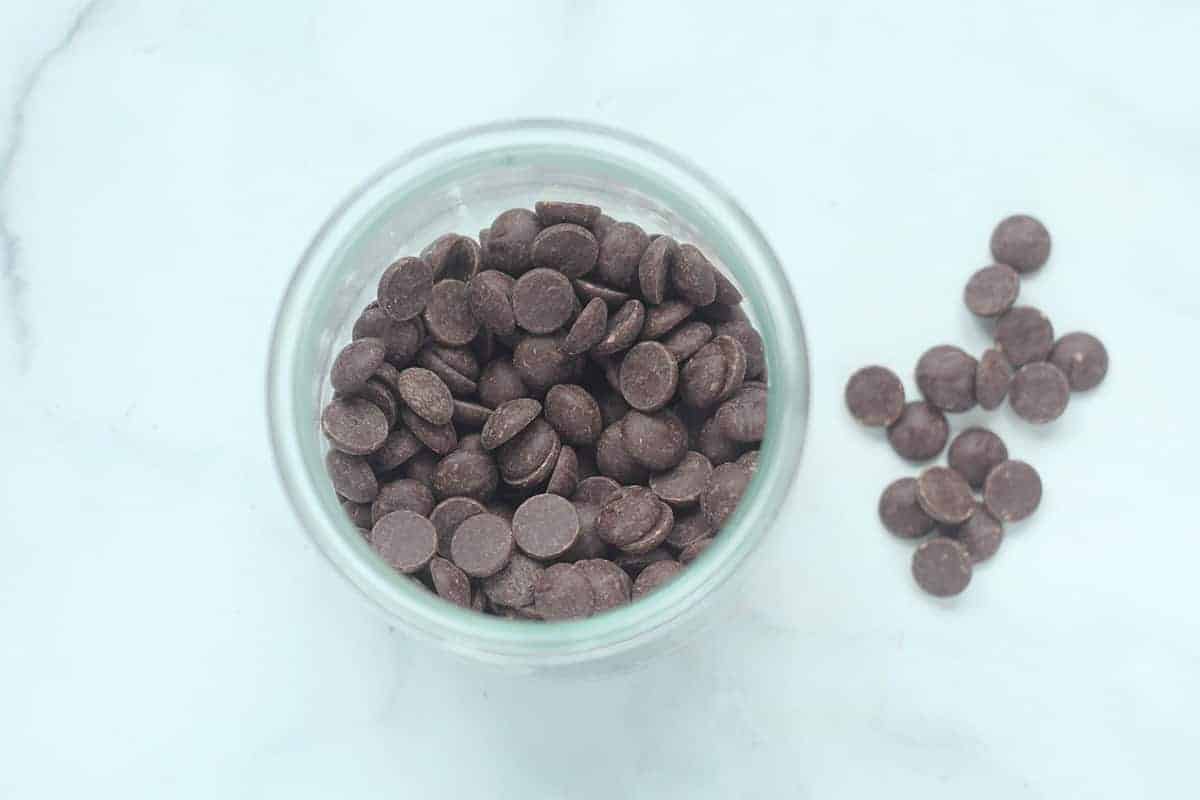
When can kids have chocolate?
The latest Dietary Guidelines recommend avoiding added sugars until kids are over age 2 and chocolate contains added sugars. Many parents also wonder about the caffeine found in chocolate.
Unlike a food such a honey, which has a real risk attached to giving it to a younger child, I think that with chocolate, we need to consider the context. Personally, I do not think it’s realistic to avoid all added sugars with toddlers until they are 2, especially if they live in a house with older siblings or eat any foods outside of the house. (It is also very nearly impossible to feed a child without any added sugars unless every single food is homemade, which is not realistic.) I would much rather we worry about our overall relationship with food and avoid demonizing specific food groups. Here’s my approach with chocolate:
- Avoid intentionally giving babies chocolate.
- Don’t worry about “introducing” chocolate to your toddler, but let it exist in your kitchen/world when you have cookies/muffins/etc with chocolate as it naturally happens.
- Avoid using chocolate as a food reward (which would give it more power!).
- Consider caffeine in context: ½ cup of milk chocolate chips has just 17 mg of caffeine. If that is divided among 12 muffins, that a little over 1 mg per muffin. (For comparison, 1 cup of coffee has 95 mg.)
When can kids have cocoa powder?
The concern with cocoa powder is that it contains caffeine, but if you choose “Dutch process” cocoa powder, most of the caffeine has been removed.
So my advice for cocoa powder is to reach for that type if you are concerned, and then it’s similar to chocolate. It’s not a food I’d worry about intentionally introducing to babies or toddlers, but is fine in the mix over age one.
It usually is used in recipes with added sugars (otherwise it’s too bitter). In the amounts we usually consume cocoa powder, I wouldn’t worry too much.
TIP: Find my Easy Chocolate Milk, Hot Chocolate, and Chocolate Avocado Pudding.
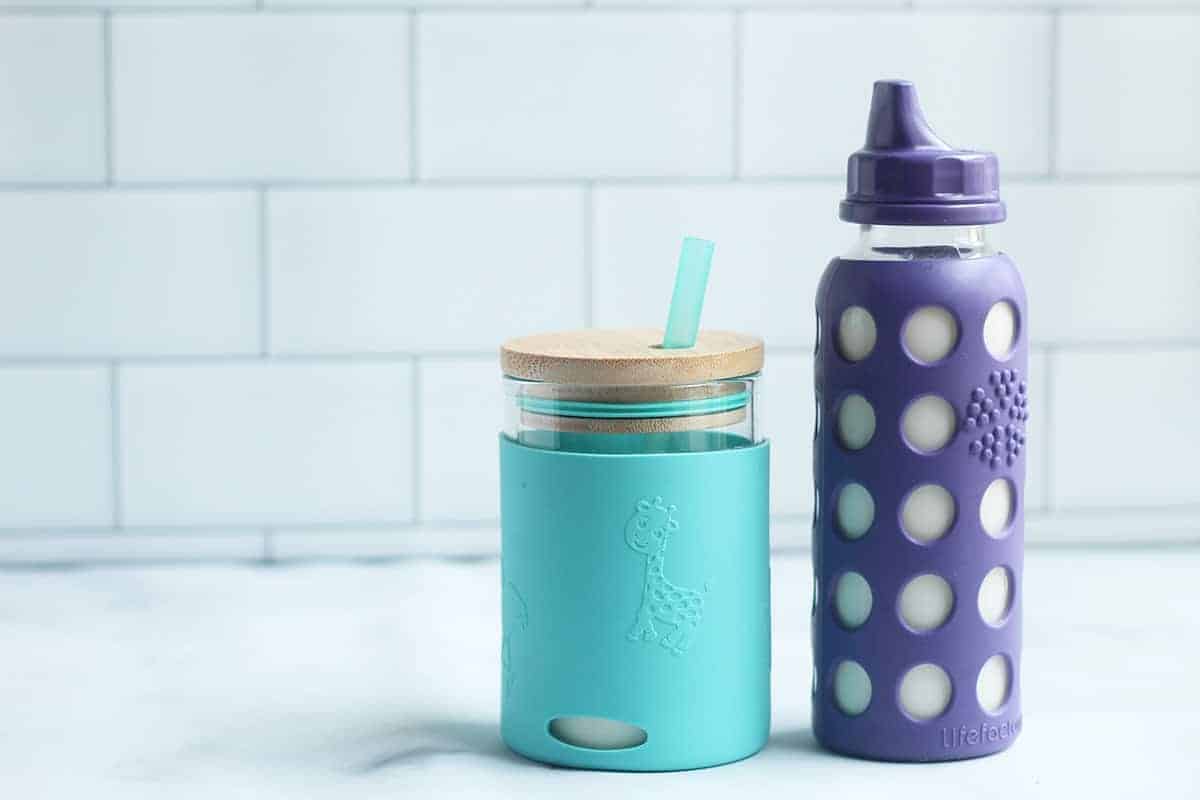
When can baby have cow’s milk? (1 yr)
The American Academy of Pediatrics recommends that we wait until a child turns one to introduce cow’s milk since it can be difficult to digest.
- 6+ mo: You can use plain unsweetened nondairy milk in cooking (or breastmilk or formula).
- 12+ mo: Use plain whole milk (or a nondairy equivalent.)
TIP: Find out more about how much milk one year olds need.
When can kids have gum? (4 yr)
Gum is considered a choking risk for toddlers since it can be slippery and hard to chew, so it’s recommended that we avoid it until age 4.
When can kids have gummies and fruit snacks? (2-4 yr)
This one is a little variable since the textures in fruit snacks and gummies can vary widely. If the are softer and easier to chew, like Annies fruit snacks, these are likely fine at age 2.
If they are at all chewy and hard, like traditional gummy bears, I would wait until 3 or 4.
TIP: Dentists don’t love chewy candies since small pieces so easily get stuck in their teeth. Offer water with them and be sure to brush!
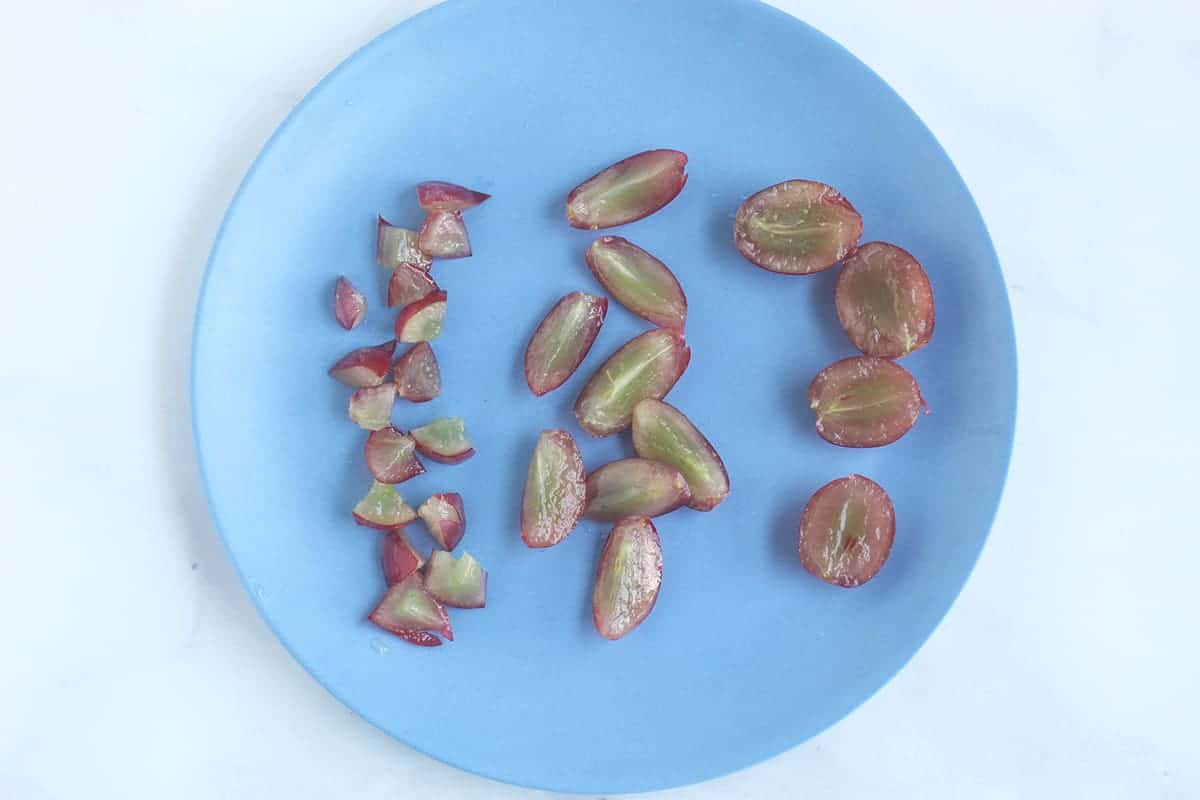
When can kids have grapes? (8/9 mo with modifications)
Whole grapes are a choking hazard for little kids. Here’s how to serve them safely to toddlers.
- 8/9+ months: Dice them up into very small pieces.
- 14+ months: Quarter them lengthwise.
- 24+ months: Halve them lengthwise.
- 4 yr+: Serve them whole (making sure the kids are sitting down while they eat).
TIP: Learn more about serving grapes to kids here.
When can baby have finger foods? (8/9 mo)
When kids develop their pincer grasp, or the ability to pick up small pieces of food with two fingers, they are ready for finger foods. Aim for the foods to be very small, easy to squish between your fingers (or dissolvable like puffs), and not too slippery.
TIP: Find my best Early Finger Foods for Babies.
When can kids have fish? (6 mo)
Fish can be introduced at 6 months, as long as you keep a few tips in mind.
- If doing BLW, offer big pieces of fish for baby to suck on. (Fish tends to flake, so baby may wind up with piece in her mouth. If that happens and it either worries you or alarms baby, you can wait on this food until 8/9 months.
- You can make an easy fish puree by blending up cooked fish with a little no-added salt broth.
- Look for low mercury options for babies including wild salmon, tilapia, and catfish.
- Save chewier fish and shellfish, like shrimp, mussels, and scallops until 8/9 months and be sure that they are very, very soft and cut up into small pieces. (Chewy shellfish is a potential choking hazard.)
- If there’s a history of shellfish allergies in your family, talk to your pediatrician before introducing fish.
TIP: You may like my Wild Salmon Salad, my Baked Salmon Cakes, and my Fish Sticks.
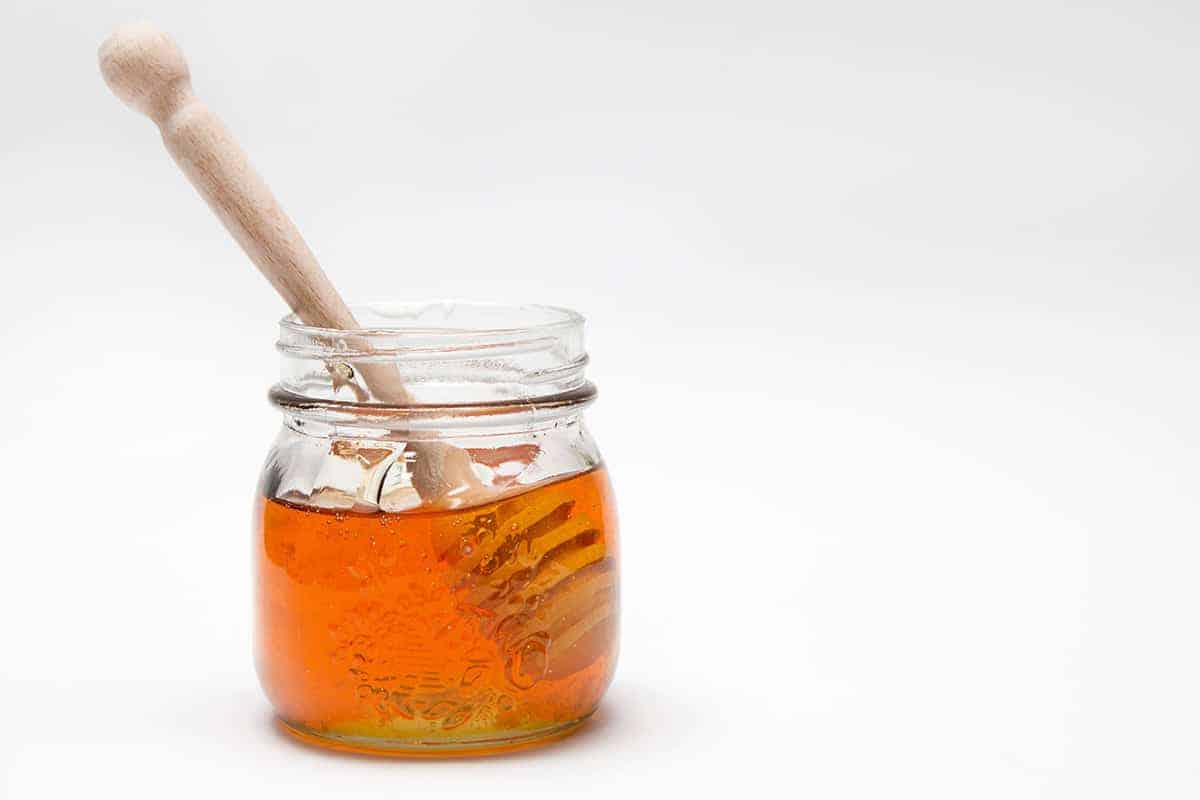
When can kids have honey? (1 yr)
Honey is a no-go for kids under age one because it can cause a very rare, but serious, condition called infant botulism. While most foods not recommended for babies are due to choking hazards or allergy concerns, the deal with honey is completely different.
Medical experts recommend that we wait until kids are over 1 year old to introduce honey since that’s when their immune systems are more developed.
TIP: Read more about babies and honey here.
When can kids have hot dogs? (1 yr)
Hot dogs can be introduced to one year olds provided you dice them up. It is not safe to offer sliced rounds of hot dog as that shape is a choking risk.
Because of the higher levels of sodium in hot dogs, serve them less often than other fresh meats and proteins.
When can kids have juice? (1 yr)
The latest Dietary Guidelines recommend that we avoid juice for babies under age 1.
For kids aged 1 and up, the DG recommend to keep daily juice to 4 ounces or less—and that it’s 100% juice. They also stress that “In the second year of
life, fruit juice is not necessary, and most fruit intake should come from eating whole fruit.”
In short, for kids over age one, aim for more whole fruits than juice. But if you do juice, try to make sure it’s 100% juice and servings are small.
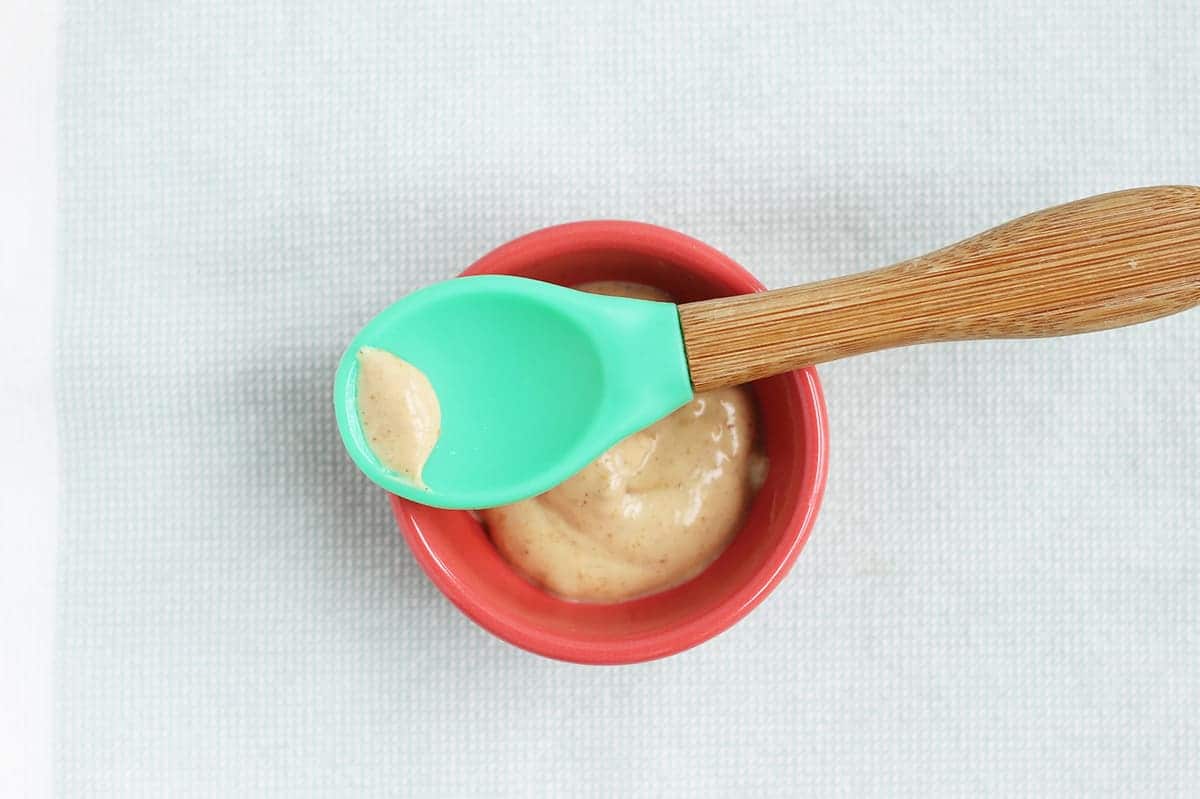
When can kids have nuts? (6 mo with modifications)
Guidelines from the American Academy of Pediatrics recommend that we introduce allergens, including peanuts, to babies soon after they start solids UNLESS there is a family history of food allergies, baby has other allergies, or the baby has had or has eczema.
Always be in touch with your pediatrician for medical advice and with any concerns about introducing potential food allergens.
Here’s the scoop on serving nuts to kids.
- 6+ months: Peanut Butter Puree (with a spoon or spread on toast) and finely ground nuts (added to yogurt or baby oatmeal) are great options.
- 22+ months: Finely chopped nuts.
- 4 yr: whole nuts (to avoid choking risks)
TIP: Find my full post on Serving Nuts to Kids here.
When can baby have peanut butter? (6 mo)
The American Academy of Pediatrics recommends that we offer potentially allergenic foods, like peanut butter, to babies soon after they start solids. This has been found to actually lower the potential for allergies—if the child does not have eczema, other allergies, and has no family history of food allergies.
TIP: Here’s my easy Peanut Puree, which is a perfect baby food and takes a few seconds to make.
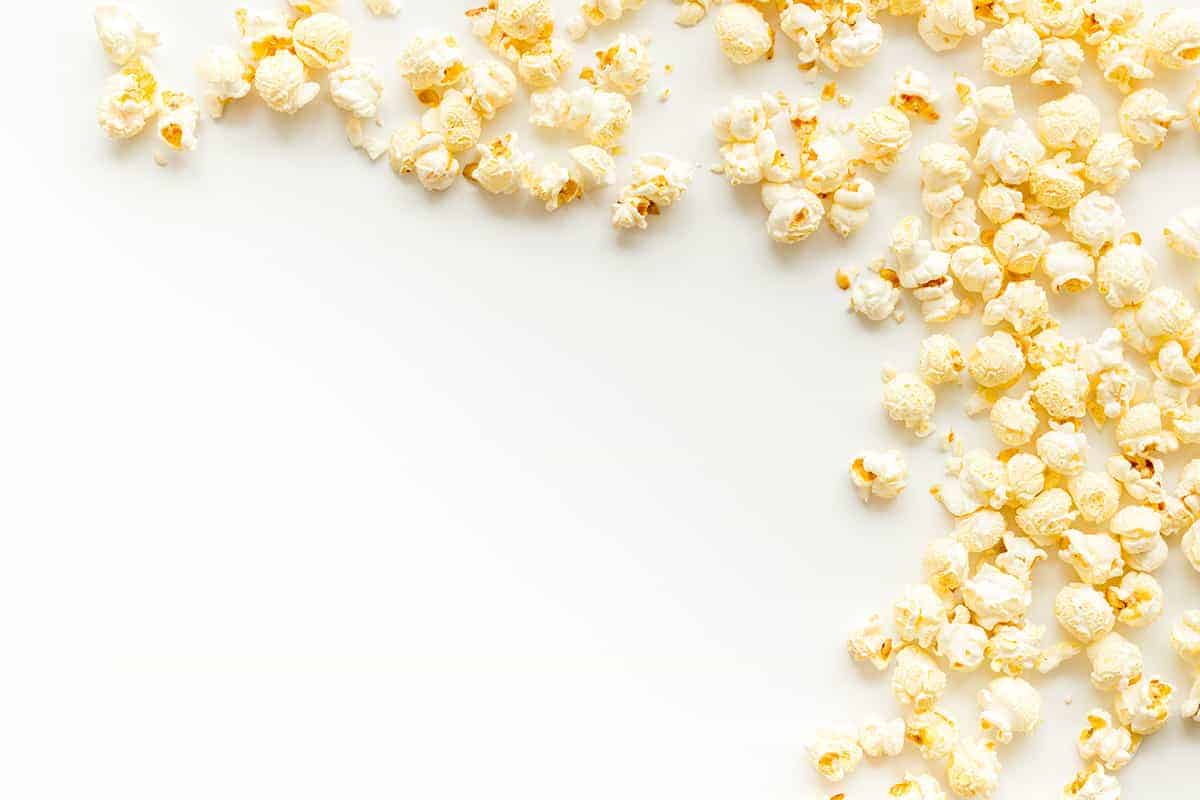
When can kids have popcorn? (4 yr)
Popcorn is high on the list of potential choking hazards for kids and is best avoided until kids are over age 4—which is the general age when they can chew more thoroughly.
Try other safer crunchy foods like puffs, Snap Pea Crisps, and soft crackers instead.
TIP: Read the full explanation on why to avoid popcorn for toddlers.
When can babies start purees? (6 mo)
The American Academy of Pediatrics recommends that we start solids when baby can sit up independently, has good head control, and is about six months old.
TIP: Find my favorite easy Baby Food Purees and tips on Starting Solids.
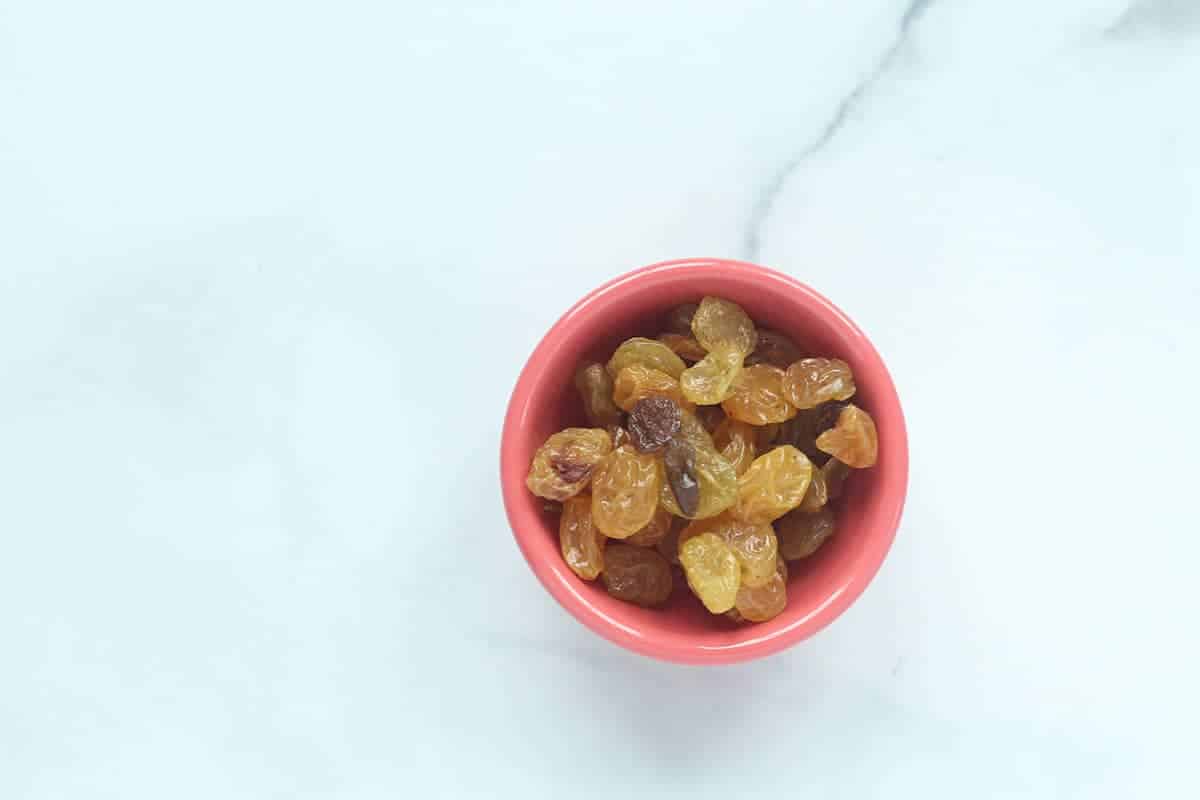
When can kids eat raisins? (1 yr)
The CDC classifies raisins as a choking risk for babies 6-12 months since they are chewy and a small round shape. Here are some tips for serving them after that.
- If the raisins are large, cut them in half with kitchen scissors.
- If the raisins are very firm, skip them (or soften them in liquid or cook them in oatmeal.)
- If you are concerned about them, you can wait until 18-20 months.
TIP: Raisins are sticky like fruit snacks, so be sure to brush those teeth!
When can kids eat runny eggs? (5 yr)
The CDC says that kids under age 5 are at an increased risk for serious illness from salmonella, which is a bacteria that can be in undercooked eggs.
It is safer to serve hard-cooked eggs, scrambled eggs, and Egg Muffins than fried eggs with runny yolks.
(Full disclaimer, we sometimes do runny eggs for our younger kids. Know the risk and decide accordingly.)
TIP: Find my full guide to making eggs for kids.
When can kids have spicy food? (6 mo)
You can (and should) serve foods with a lot of flavor from the start and the spice level will vary based on your culture and your own food preferences. I would stay away from serious heat and spice, which could be alarming to kids, but flavors from herbs, less hot spices (like chili powder) and the like are okay to include.
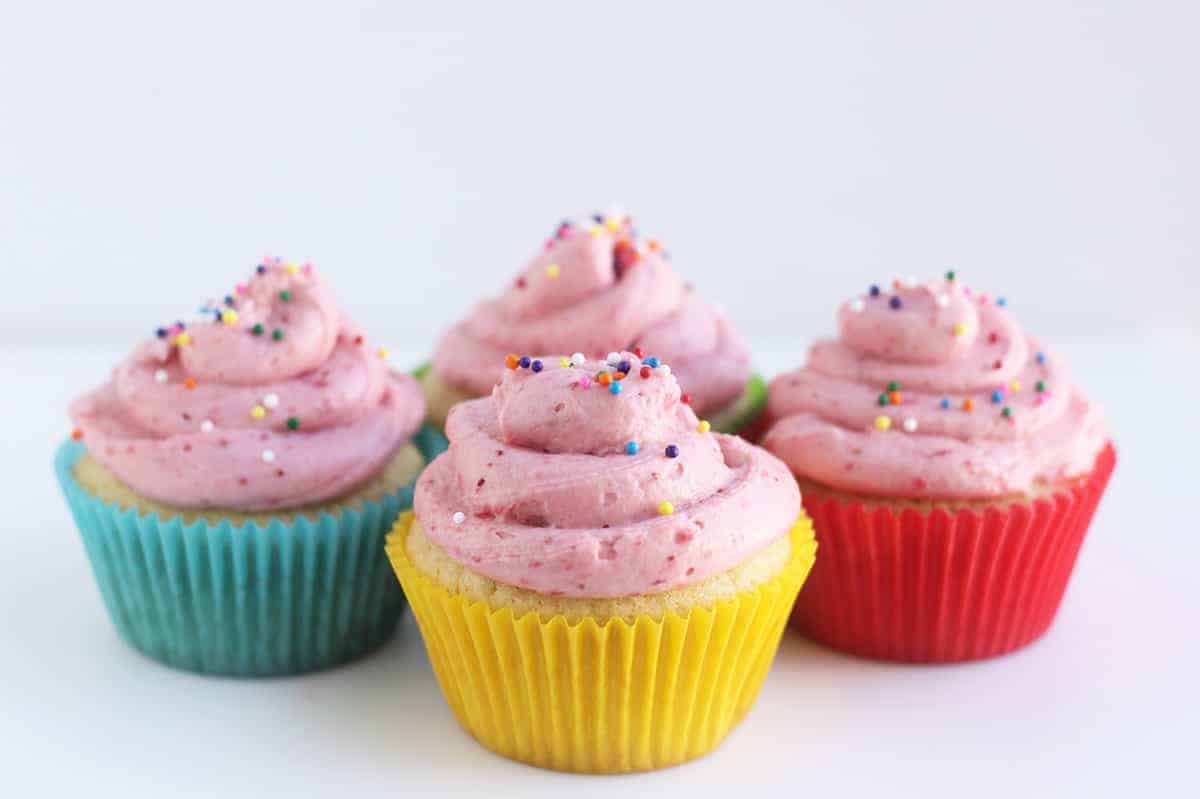
When can kids have added sugar?
The latest Dietary Guidelines recommend no added sugar under age 2. They have good motivations in wanting to help kids learn to eat more whole, less overtly sweet foods, but I find the advice to be completely unrealistic for families who buy anything from the store. (Because the majority of store bought food has added sugar.)
Here’s what I aim for:
- Aim to serve mostly foods without added sugars.
- With staples like yogurt and milk, reach for unsweetened plain options, then add flavor from fruit, purees, and mix-ins like jam and honey that you have more control over.
- If you have the resources and the desire, by all means, make everything from scratch.
- Try not to obsess about sugar grams in packaged foods and instead look at the proportion of the foods you’re serving. (Aim for more whole foods and fewer packaged snacks.)
TIP: Find my full explanation and views on sugar and kids here.
When can kids have sushi? (2 years)
There are a lot of variables with sushi, but the American Academy of Pediatrics gives some good tips. They say that families in Japan usually wait until 2-3, but some wait until kid are 5. And they suggest:
- Start with vegetarian sushi like avocado rolls and cucumber rolls. These are great options for 2 year olds and up. (Take them apart for one year olds as the seaweed can be hard to chew.)
- Choose low mercury fish options like yellowfin tuna, skipjack tuna, or salmon.
- Avoid raw shellfish as it has a higher risk for food borne illness.
TIP: I’m not super comfortable giving raw fish to my two year old, but he loves avocado rolls and my almost 5 year old loves salmon avocado rolls!
When can kids have tortilla chips? (4 yrs)
Hard chips like tortilla chips are very challenging to chew and are a choking risk until kids are around age 4 and better able to thoroughly chew. I’ve had two kids get pieces of tortilla chips stuck in their throats when they were close to age four, so I am very aware of the reality of the risk here.
- Try crunchy food that are softer like Snap Pea Crisps, softer crackers, Peanut Puffs, Cheese Puffs, and the like.
TIP: Find my go-to Healthy Snacks for Kids to Buy at the Store.
When can baby have water? (6 mo)
It’s recommended that we wait until baby is 6 months to have sips of water with meals. Before that, breastmilk or formula are all that babies need to grow and stay hydrated.
TIP: Find more in depth info on babies and water.
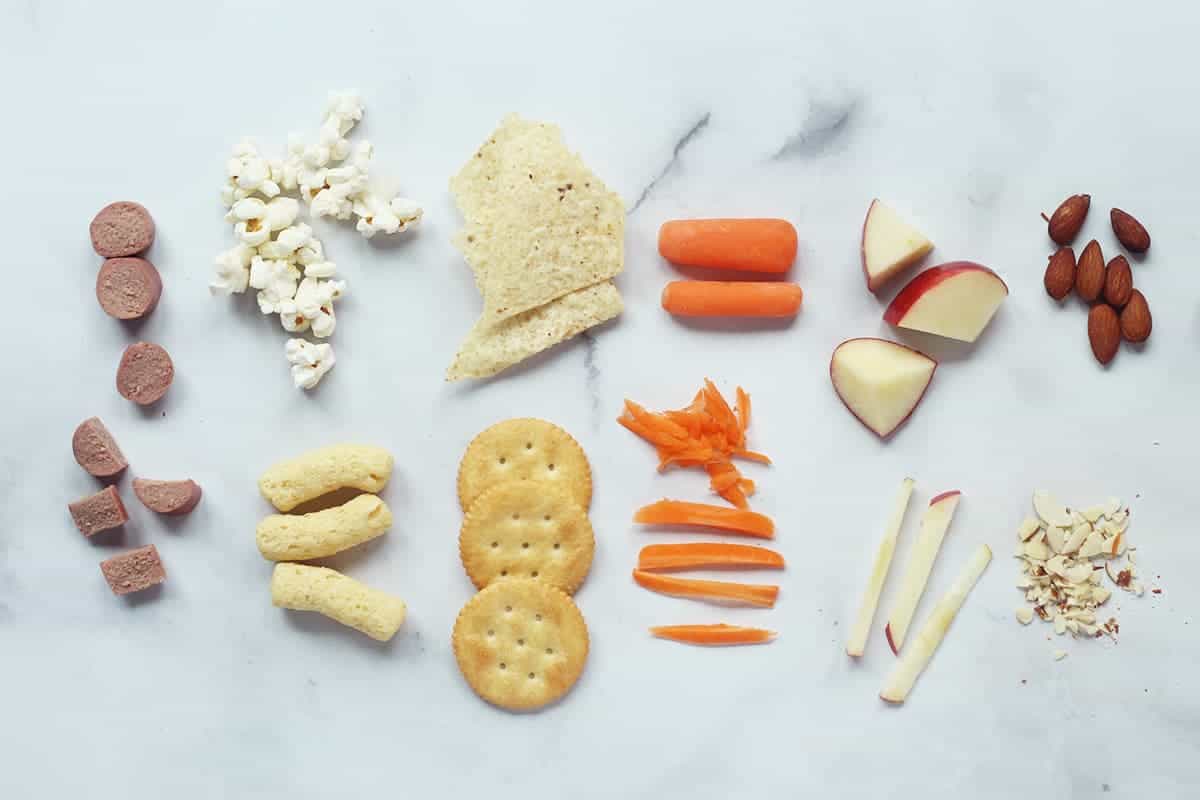
More Food Choking Hazard Info
Lower the risk of toddler choking hazards by knowing the most common food items that tend to be tricky for kids—and safer ways to serve them.
On the image above, instead of the options on the top row, serve the safer options along the bottom.
Related Posts
What did I miss? Let me know in the comments and also if you have any questions!
This post was first published on April 6, 2021.
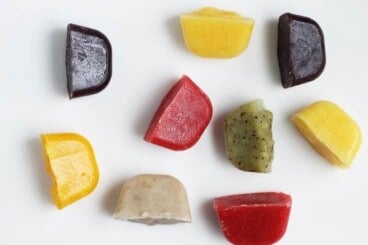

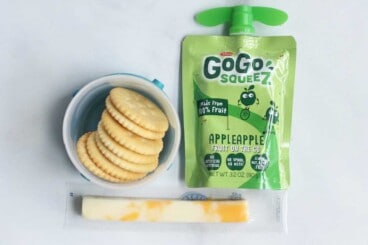
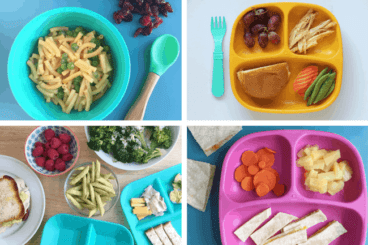



















Hi Amy,
Thank you for this and I LOVE your recipes! What about peas? My son (15m) LOVES sweet peas (defrosted from frozen), but they worry me. I squeeze each pea to “pop” it before I give them to him. What are your thoughts on when it is safe to serve them whole?
Thanks!
Nicole
Hi! Usually with standard size peas, they are safe (assuming soft) to give 9+ months. So your kiddo is likely totally fine to have them. Try a few and see, but they are usually an okay size to eat whole once kids are on finger foods.
Hi Amy,
I was wondering about blueberries? At what age is it recommended to keep cutting them and when can they eat them whole?
Thanks!
If they are normal size and soft, it’s usually fine to stop cutting them by 14/16 months (I know some people are nervous about them and cut them longer but that’s been my experience)
What about raw meats? I eat medium steaks and always concerned to cook his pieces longer. This was very helpful!!
From what I can find “undercooked meats” are a higher risk for kids under age 5 (per CDC), but I can’t find specifics on how that term is defined. You could ask your pediatrician too. (I personally would not serve rare meats but I would be okay with medium if all other food safety standards are being followed.) I’ll update this if I can track down more specifics!